Your average cheap, crappy USB drives are just that: cheap and crappy. Going a little bit further will
get you a drive that runs circles around the cheap ones while lasting significantly longer. There are a lot of USB drives to choose from, though, and even more to be grabbed out of “dollar bins” while you’re waiting in line at the store. Knowing which to pick can be difficult when there’s such a wide range of prices, speeds, and shapes. I tested over a dozen different drives to find the fastest at the best price. The best USB drive Feels underpriced for its speed USB plug uses a simple spring mechanism that feels smooth and sturdy N/A If you've never bought a nice, fast USB drive, it's probably because you already have a couple cheap ones lying around.

If you've never bought a nice, fast USB drive, it's probably because you already have a couple cheap ones lying around. Everyone wants their file transfers to go faster, but who wants to pay for it? You really don’t have to spend very much money to get a significant boost in power, though, and the 32GB SanDisk Extreme CZ80is proof of that. Out of all the drives I tested, it represents the most bang for your buck.
The most impressive thing about this drive is that its speeds aren’t anywhere near the budget category, despite the price. In the large file test, it averaged a read speed of 229 MB/s and a write speed of 178 MB/s. Though that test didn’t reach its advertised speeds of 245 MB/s read and 190 MB/s write, it came very close and actually surpassed those numbers in the CDM test. Its small file testing proved somewhat worse for read speed, 123 MB/s, but still stayed ahead of anything near its price for write speed, 56 MB/s. These numbers actually come close to the drives I was testing in the high-end category—including the “pro” version of the CZ80, the SanDisk Extreme Pro CZ88—but at a significantly cheaper price.
CrystalDiskMark results

The CZ80 is also one of the nicer looking and easier to use drives I tested. It shares the same body as the CZ88 but in black instead of silver, and I can see why SanDisk would want to reuse the design. It’s slim and smooth with a slider to push out the USB plug. The slider has a bit of a spring action to it, meaning you only have to push it part of the way and the drive does the rest of the work for you. It has a catching mechanism when the plug end is pushed out but not when it’s pulled in, making it easy to quickly “uncap” while also preventing you from pushing the end back in while you trying to plug it into your computer. The keychain loop is also quite large, making it much easier to thread than most of its competitors.
There are definitely faster drives—if you are looking for raw speed then check the next page for our high-end choice—and there are definitely cheaper options, but the CZ80 strikes a great balance between the two. It actually feels under-priced for the speeds it can reach. It’s such a fast drive that I can confidently recommend that this is the one you should get, even if you have extra money to burn. Going higher than this will get you more speed, but at an extra price that probably isn’t worth the money.
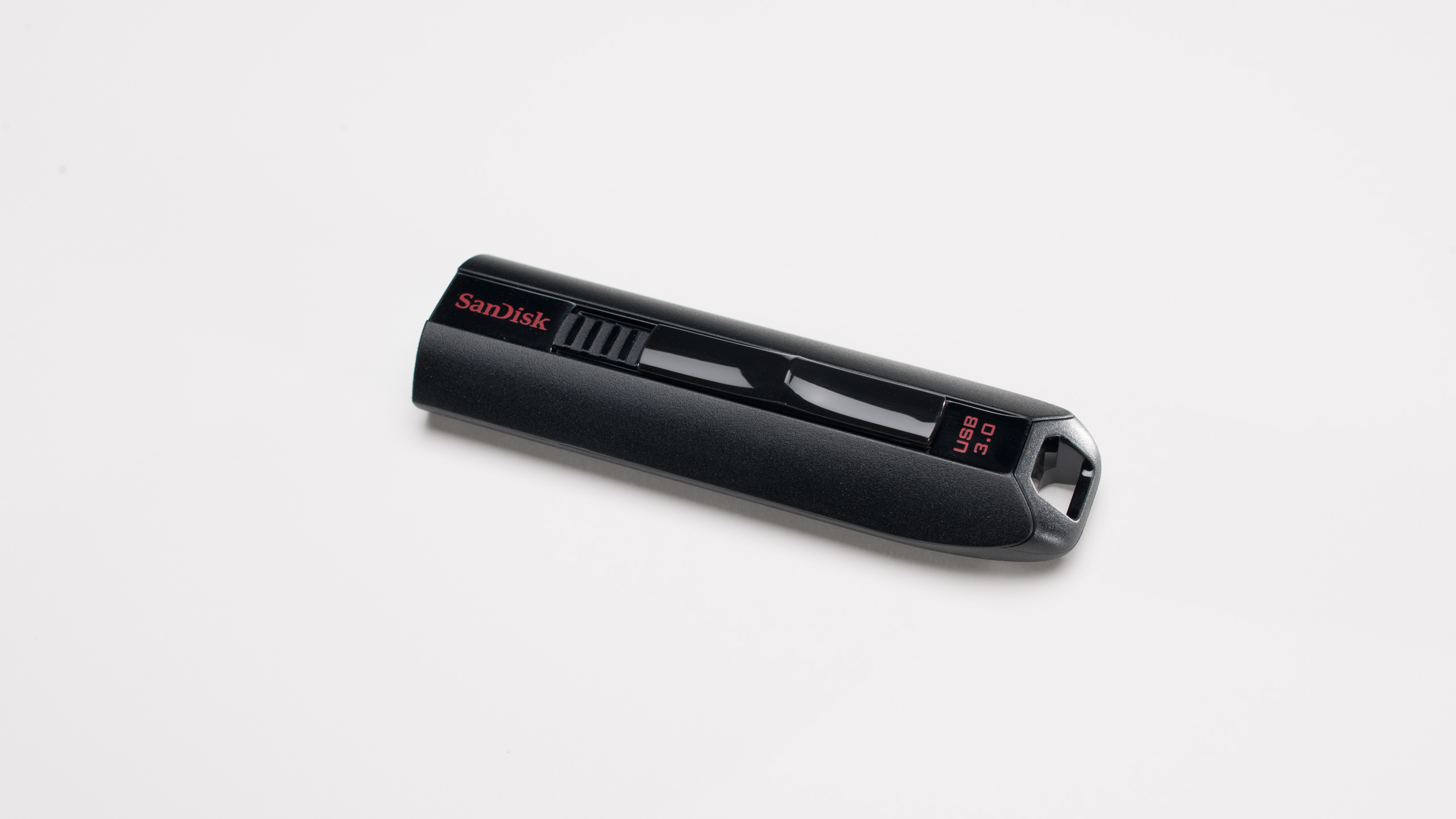
Even if you aren’t worried about hitting the highest possible speeds and just want a good USB drive to move files around, theis still the way to go. It’s not too expensive and will save you headaches and frustration as you watch that 2GB movie file transfer in 10 seconds as opposed to the 5 minutes a junky USB 2.0 drive would take. A good USB drive is always a relevant tool to a PC gamer, and the CZ80 is worth investing in just like any other part of your rig.
Read More The best high-end USB drive Small, sleek design The fastest overall drive we tested, with over 300 MB/s read speeds Expensive for simple, everyday file transfers
The best high-end USB drive Small, sleek design The fastest overall drive we tested, with over 300 MB/s read speeds Expensive for simple, everyday file transfers
We’ve covered the drive that strikes a balance between price and power, but what if you just want the fastest USB drive you can get your hands on? That’s exactly what the 128GB Patriot Supersonic Rage 2brings to the table. It’s got more storage than my personal rig’s SSD—and it costs more—but it has a lot of speed and space in a very tiny package. In fact, it’s probably the tiniest way to store this much data you can find.
With the second-highest advertised read and write speeds of all the drives I received for testing, I had high hopes but realistic expectations. The Rage 2 is listed as having a read speed of 400 MB/s and a write speed of 300 MB/s, and while it predictably didn’t reach those high numbers it actually came surprisingly close. The large file test averaged 354 MB/s read and 187 MB/s write, while the small file test clocked in at 180 MB/s read and a much lower 34 MB/s write.
crystaldiskmark results

That write speed may seem damning, especially when put next to the 300 MB/s it claimed to get, but it’s important to keep in mind that pretty much every drive I tested performed drastically worse in the small file test than any other benchmark. Only a few of the drives made it above 40 MB/s write for that test, while only one managed beat the Rage 2’s small file read speed.
The Rage 2’s form factor is one of my favorite things about it, and one of the primary reasons I chose it over its closest competitor, the Corsair Flash Voyager GS. Even though it holds 128GB (and also has a 256GB version) it’s one of the smallest drives I got my hands on. It’s slim, flat, and its sliding cap means it takes up even less space when you plug it in. The slider clicks satisfyingly into place when it’s pushed in or pulled out.
It was difficult to understand why some of the other drives were so bulky while the Rage 2 was designed to be so sleek and small. There is value in making a drive difficult to lose track of, but the Rage 2’s bright colors and easy to use keychain loop meant that wasn’t a concern. Additionally, it left all the other drives in the dust in terms of read speed—with the exception of one, the Corsair Flash Voyager GTX, which had better read speeds but significantly worse write speeds. This why the Rage 2 really shined; while other drives could beat it in certain tests, no other drive was so consistently at the top of every test. Put that in an attractive case and you have the best high-end USB drive money can buy.
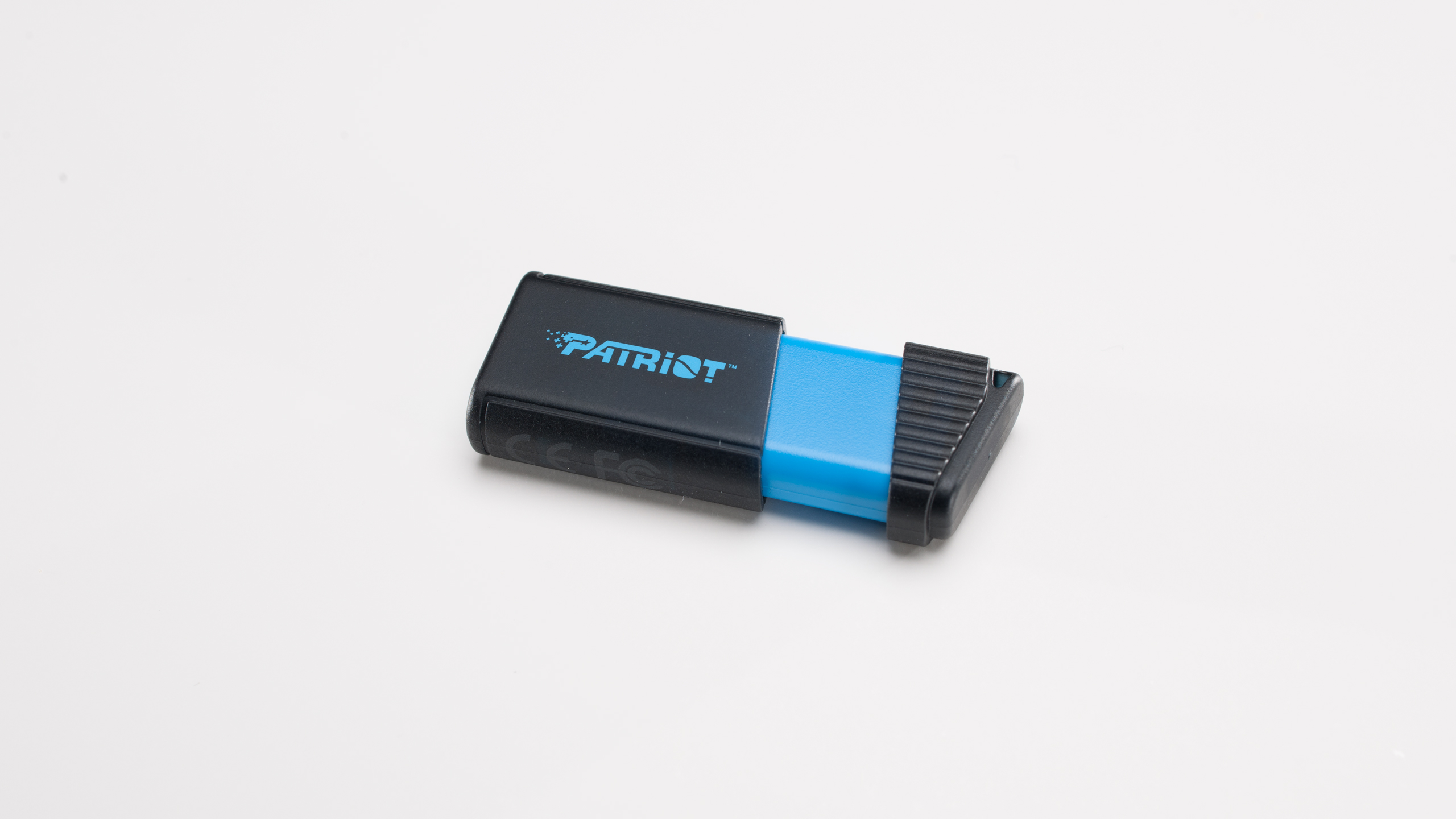
Your average gamer isn’t going to need the amount of storage theprovides, but everyone can benefit from the speed. If you transfer files on a daily basis and want to gain back hours you’ve wasted waiting on slow transfers, this drive is your answer. If you’re just looking for a fast drive for personal use, jump back a page and give the SanDisk Extreme CZ80 another look.
Read More The best budget USB drive Far faster than a bargain bin USB drive, but still a bargain price Small metal body with a secure cap Slow compared to our favorite drive
The best budget USB drive Far faster than a bargain bin USB drive, but still a bargain price Small metal body with a secure cap Slow compared to our favorite drive
Still not convinced that you need blistering fast speeds in a USB drive? Well fine, but I really can’t stress enough that you shouldn’t settle for bargain bin drives made of cheap plastic and broken promises. They won’t take advantage of USB 3.0’s significantly faster speed caps, and they’ll bring you nothing but frustration every time you wait for a file to transfer. If you want to go cheap, get the 16GB ADATA Superior Series S102. It's wrapped in a durable body, doesn’t cost much more than lunch, and it blows crappy USB 2.0 drives out of the water.
crystaldiskmark results
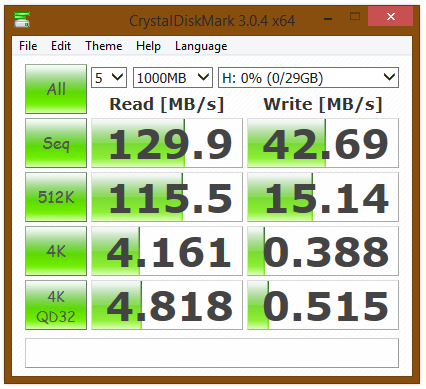
The S102 is advertised with 100 MB/s read and 50 MB/s write speeds, and ended up testing pretty close to those numbers. It actually reached 116 MB/s read in the large file test, but it never quite hit its listed write speed, only averaging 36 MB/s. Still, these are pretty impressive speeds for an $9 (£6.23 GBP) drive, and its speed consistency was a good sign. The small file test saw a read speed of 84 MB/s and a write speed of 21 MB/s but, as I’ve said before, most of the drives I tested performed much worse with small files than large ones. Overall, it had decent and consistent speeds at a price much lower than you’d expect.
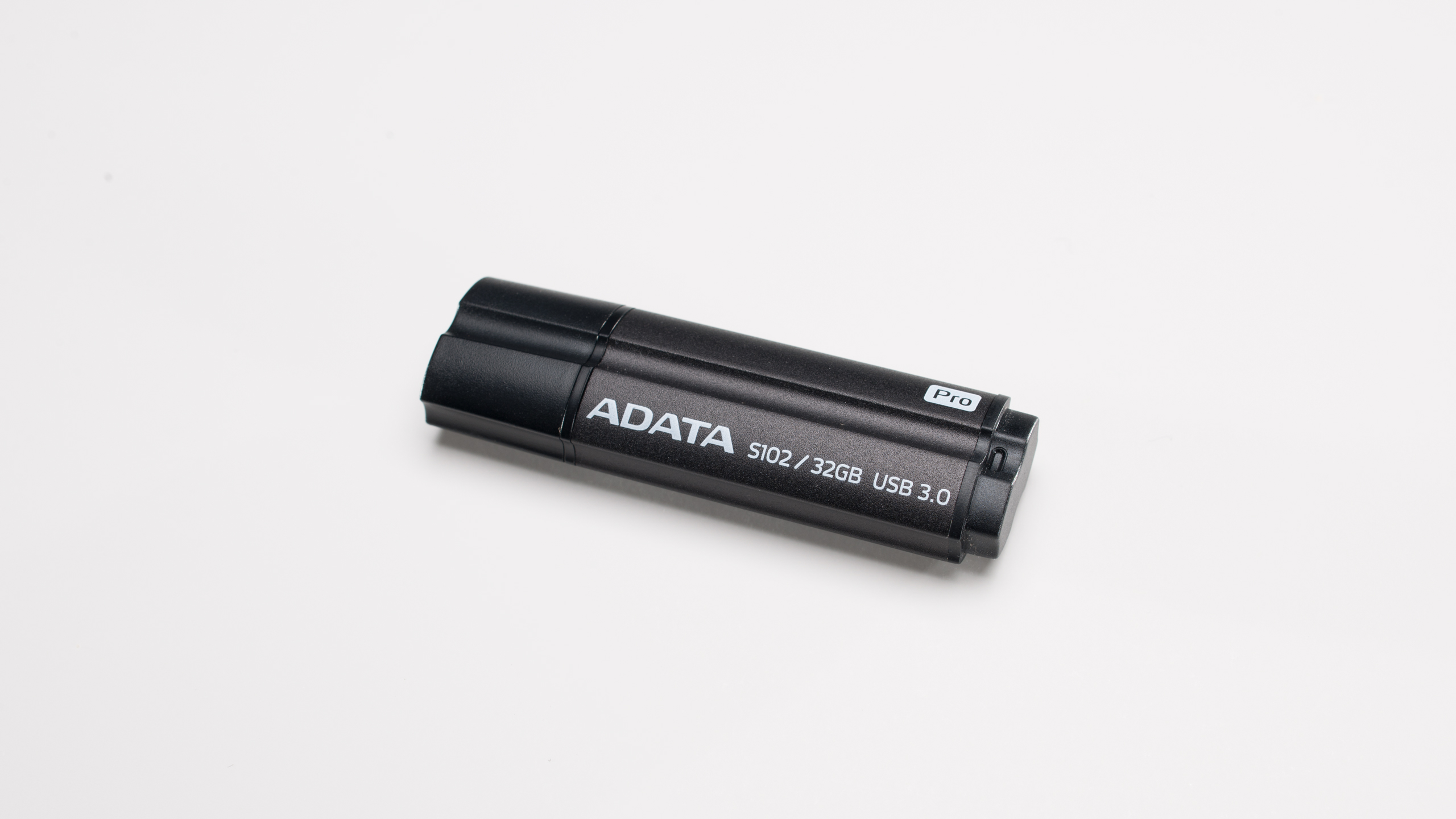
Lexar M20c - 32GB
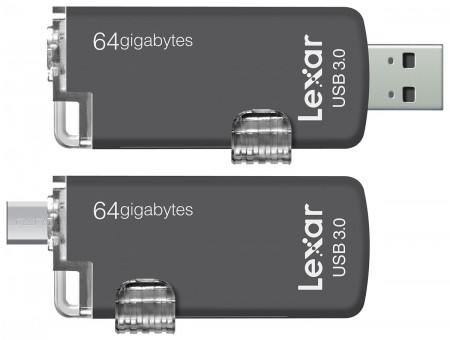
Another good budget option, the Lexar M20cis the only drive we've tested that has both a standard USB plug and a Type-C plug that can be used interchangeably.It's a drive on the cheaper end of things, performing better than the S102 for a couple dollars more, but the cheaper choice from ADATA is still your best bet in the budget category.However, if you are looking to future-proof your USB drive or already have a motherboard with a Type-C port, The M20c is well priced for its speeds, and provides a nice bridge between the two plug types.
One factor that seemed to have no correlation to a drive’s price was its body and shape, as the S102 is actually one of the best I saw. It’s very small, especially when compared to higher priced drives. The S102 has a metal body and a removable plastic cap instead of a slider. I’m usually not a fan of caps, but this one has a catching mechanism that keeps it very securely in place. It can also be snapped onto the back of the drive when it’s plugged in and works well enough that it won’t just fall off with a slight bump. My fear with removable caps is that I’ll inevitably lose them, but this one feels hard to lose.
The S102 is definitely not the fastest drive I tested, but you get a surprising amount of power for a very low price. Its speeds were only slightly slower than both of the low-profile drives I tested (see the next page for my low-profile choice) for a few dollars cheaper. A few dollars might not be much at higher prices, but when the drive is $9 it can make the difference. And if you are willing to spend $3 more, you can double the storage capacity to 32GB.
If you don’t want to spend $21 (roughly £14 GBP) on a USB drive, then the ADATA Superior Series S102is the way to go, especially over an outdated USB 2.0 drive. The S102 will give you a noticeable and significant boost in speed for a very small price. It also has one of the nicest form factors of any of the drives I used, regardless of price or speed.
Read More The best low-profile USB drive As portable as a USB drive can get. Great for a keychain Tiny enough to leave plugged into a laptop at all times Easy to lose Slower than our favorite drive
The best low-profile USB drive As portable as a USB drive can get. Great for a keychain Tiny enough to leave plugged into a laptop at all times Easy to lose Slower than our favorite drive
Now that we’ve covered your best speed options at different price points, it’s time for something a bit different. Low-profile USB drives are ones that barely extended past the edge of the port you plug them into, and the best one you can get is the 32GB SanDisk Ultra Fit CZ43. A low-profile drive needs to be as small as it can possibly be while still staying functional, both in speed and convenience. It shouldn’t take up room, but you should still be able to fit it on your keychain or get it back out of the plug after you’ve put it in.
The CZ43 wasn’t the fastest drive I tested—as I mentioned earlier, rating only slightly faster than my budget pick for only a couple dollars more—but it was definitely faster than any USB 2.0 drives and is well worth the upgrade. In the large file test it had a read speed of 129 MB/s and a write speed of 31 MB/s, while in the small test it averaged 87 MB/s and 22 MB/s. Both of the low-profile drives I tested had CrystalDiskMark speeds faster than what they were advertised for, but performed very similarly in the practical tests. These speeds aren’t amazing, but you shouldn’t be looking at the CZ43 if you’re only concerned with a drive’s speed.
crystaldiskmark results
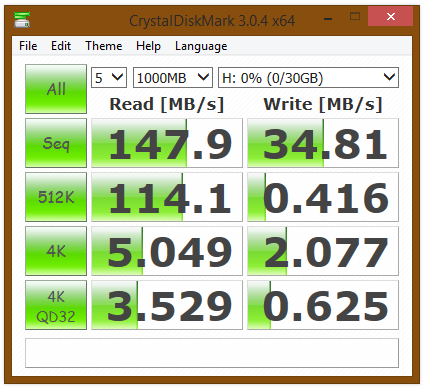
The shape and form factor is what really counts in this category, and the CZ43 shines here more than anywhere else. The drive hardly juts out of the USB port at all, and its end is rounded black plastic which allows it to pretty much disappear against your computer while plugged in. The end also has a red LED hidden under the plastic that acts as an indicator light when it’s getting power. The light is very helpful in making sure the drive is in all the way, and is otherwise completely unnoticeable.
Admittedly, the keychain loop is a little bit difficult to thread and the CZ43 comes with a cap that has nowhere to go while the drive is in use. I usually don’t like free-floating caps on USB drives, but since this one isn’t much more than the plug end itself, the extra protection while it’s in your pocket is appreciated.
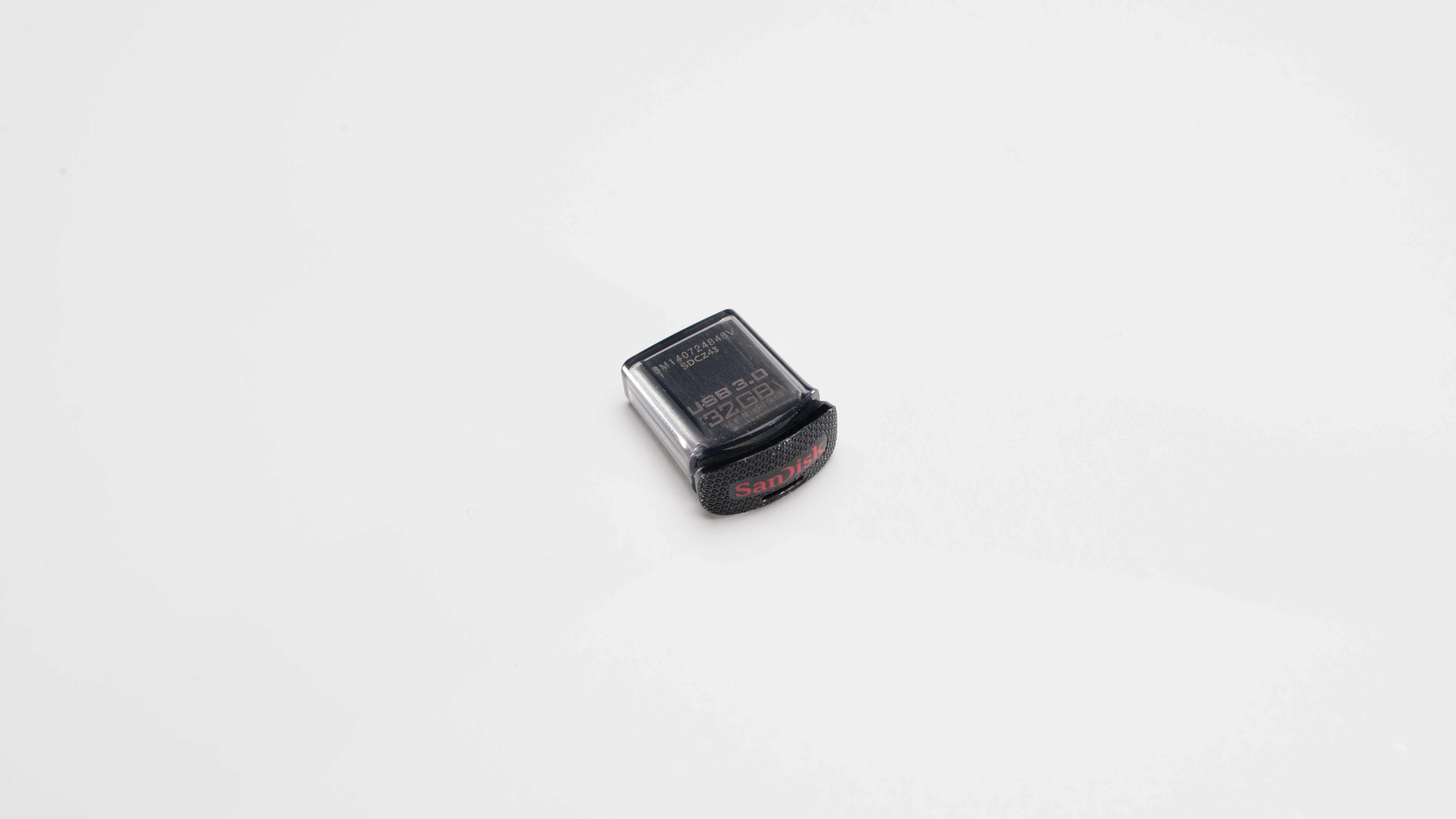
In fact, the CZ43 was one of the only low-profile drives I could find that had a cap at all, which was surprising given these drives aren’t much more than exposed hardware. Once again, it wasn’t the fastest drive I tested, but it was definitely the smallest. Realistically, the speed difference compared to other low-profile drives is negligible, and the CZ43 is slightly cheaper anyway. The smoothed black end also made it more aesthetically appealing while plugged in and easier to remove. For the record, no low-profile drive is easy to unplug once it’s in there, but this one was the easiest.
A low-profile drive definitely isn’t for everyone, but if you are specifically looking for one then theis the way to go. You can get higher speeds for only $10 more or similar speeds for $2 less, but neither of those options come in nearly as small a package. If you are looking for extreme speeds while still staying relatively small then our high-end choice, the Patriot Supersonic Rage 2, will still satisfy but at a much higher cost. A low-profile drive fills a very specific need, and the CZ43 fills it better than any other option.
Read MoreHow we test USB drives and others we testedUSB drives might not have much to do specifically with PC games, but every PC gamer will need one at one point or another. As PC gamers, we always want the best and the fastest when it comes to our computers, but our choice of portable drives will often fall to the wayside. Using any old USB drive seems fine, until you end up waiting 30 minutes to transfer a file.
When it comes to testing USB drives, speed is king. A drive's read (taking files off of it) and write (putting files onto it) speeds determine how long you’re going to be waiting on file transfers. Read speeds are almost always higher than write, so a drive with a high write speed is a treasure. Additionally, a drive will read and write differently depending on the size and quantity of the files being transferred, so it needs to perform well in multiple scenarios. Beyond raw speed, a USB drive needs to be convenient and comfortable to use. Does it block adjacent USB ports? Does the cap snap onto the back or sit idly on your desk when it’s off? And finally, what are you paying for the performance?
After a lot of testing and spending some practical time with each drive, the SanDisk Extreme CZ80is the USB drive I’d recommend to PC gamers. Its read and write speeds are up there with the fastest ones I tested, but at a much lower price. It even outperformed its “pro” version in some of the tests I ran. The CZ80 has a slim body that doesn’t take up much space and doesn’t block any other ports. It’s the perfect example of how paying only a little bit more for a good USB drive can represent a significant step up in quality.
The SanDisk Extreme CZ80 is my overall recommendation, but I also picked out the best high-end drive if you just want raw speed, the best budget drive if want great speeds at an rock-bottom price, and the best low-profile drive for those who don’t want their USB drives to stick out from their computer (these are ideal for laptops or as permanent expanded storage).

I primarily tested all of the drives on our living room gaming machine, LPC Jr., with follow-up testing and some double checking on another equally powerful rig. For consistency, I formatted all the drives to NTFS before I moved any files onto them and used the same USB 3.0 port on the motherboard I/O panel every time. I also ran all the tests in the same order and didn’t use the drives for anything else before I tested them. Some of the drives I recommend are a different capacity than the ones I tested of that model. While larger drives generally read and write faster, I made sure that all the drives I was comparing for a category were the same size for consistent results.
Each drive went through the same testing process: a benchmark using the CrystalDiskMark software, a practical test of transferring lots of large files, and a practical test of transferring lots of small files. While a drive's read and write speeds are usually their most important factor, I also took price, form factor, ease of use, shape, and other things into consideration while testing.
Benchmark one: CrystalDiskMarkThe first test was fairly straightforward: I used the Standard Edition of CrystalDiskMarkto get a baseline idea of what to expect from each drive. CDM tests the read and write speed of each drive in four different ways: sequential, random 512K, 4KQD1, and 4KQD32. The most important number to look at here is the sequential speeds as that’s what most closely reflects how we actually access files from a USB drive. The random 512K and 4K tests would be important if you are planning on installing an OS onto your drive, but are less indicative of its practical performance.
While I did take the CDM results into consideration, I found that the sequential read and write speeds from the benchmark were consistently higher than what I got in the practical tests. The CDM speeds represent the ideal scenario of what the drive can do, often starting out at this number but slowing down during large bulk file transfers. Therefore, I used the CDM sequential speeds as a baseline for my judgment, but placed more value in the practical tests.
Benchmarks two and three: large and small file testsFor both the large and small file tests I used a program called RoboMirror, which adds a GUI to the Windows utility Robocopy. Using RoboMirror is the exact same as if I had dragged over the files by hand, expect it keeps careful track of how long a copy job took and lists the average MB/s speed. This way, I could perform real world tests of moving files to and from the USB drives and get precise numbers on how quickly the drives were working.
The first practical test was with large files. I made a folder of roughly 32GB of video files, 20 total ranging from 1-2GB in size, and copied them all at once to a USB drive using RoboMirror to get the write speed. I then copied them back to the computer to get the read speed. For the 32GB drives, I used a folder with 16GB of files instead and did the same with the drives I was comparing them against to stay consistent with the tests.
The second practical test was the same basic idea, but with lots of small files. I made a folder of roughly 15GB of images, almost 10,000 total. I copied them to and from the drives, making note of the read and write speeds. Storage devices handle a bunch of small files differently than large ones, so testing both ways let me see how it would perform in a few different situations.
CompetitorsI benchmarked and tested more than a dozen different USB 3.0 drives to find the best in each category. A lot of it came down to pure numbers, but there were a bunch of reasons I did or didn’t pick one. How much power are you getting for your money? Would it fit on your keys? Does it get too hot after a while? What is the trade-off between read and write speeds? All of these factors had an influence, and some shined in a certain category but didn’t end up as my pick overall.
The Kingston HyperX DataTraveleractually outperformed all but my high-end pick when it came to read speeds on the small file test, but didn’t shine anywhere else. Though it doesn’t hit the speeds it claims, it’s definitely a fast drive. The main problem is that it costs more than the SanDisk Extreme CZ80 for consistently slower speeds. It’s not bad by any means, but there’s just no reason to get it when you can pay less to get more.
The Kingston HyperX Ultimate DataTraveler got faster read and write speeds than it claimed on its packaging, but still not as fast as the SanDisk Extreme CZ80. It also has a small Kingston emblem hanging from it’s keychain loop that can’t be removed which I found annoying, though that is only an aesthetic problem.
The ADATA DashDrive Elite UE700had impressive read speeds, but its write speeds didn’t hold up compared to similarly priced drives, though it is on the cheaper end of them. It should be noted that it is by far the thinnest drive I tested, aside from the low-profile ones, and isn’t much thicker than the plug itself. It also comes with a faux-leather strap, but all this comes at the price of speed.
The SanDisk Extreme Pro CZ88is the “superior” model of the SanDisk Extreme CZ80, but I didn’t find it to be much faster. Its CDM benchmark showed similar numbers, and the practical tests were almost identical. The only exception was its write speeds in the small file test, which it averaged at 120 MB/s and blew every other drive I tested out of the water. Still, the price is a lot more to pay for an improvement in only one area.
The VisionTek 120gb SSDwas a drive I was looking forward to testing but incredibly disappointed by. It claimed to get 455 MB/s read and 440 MB/s write, but couldn’t get anywhere near that. Its CDM benchmark showed 215 MB/s read and 139 MB/s write, and the practical tests showed it going even slower than that. It did, however, outperform every other drive in CDM’s 4KQD1 and 4KQD32 tests by a shocking amount. Where other drives were getting 1 MB/s write speeds for the 4KQD32 test, the VisionTek SSD hit 100 MB/s. The drive is pitched as a bootable OS solution and could definitely do well in that role, but it’s too expensive for average speeds to be used just as a USB drive.
By adjusting some motherboard settings, we retested this drive and were able to reach speeds much closer to those advertised. However, the fact still remains that for nearly half the price you can find comparable speeds and more storage space in the Patriot Supersonic Rage 2. Other USB drives with SSD controllers are in a similar position: to get full speed from them, you need XHCI enabled on your motherboard and an OS (Windows 8 or 10) and motherboard that can support the turbo-speed UASP protocol. In other words, these drives can offer fantastic performance in ideal circumstances, but we think the Supersonic Rage 2 is a better high-speed drive for most people.
The Corsair Flash Voyager GSwas definitely second in line for my best high-end pick. It narrowly beats the Patriot Supersonic Rage 2 on write speeds (213 MB/s to 187 MB/s for the large file test) but is then beaten by a wider margin on read speeds (215 MB/s to 354 MB/s). The straw that broke the camel’s back was actually its form factor. Both of the Corsair Flash Voyager drives are really big. I mean too wide to use the USB ports on either side of them while it’s plugged in big, unless you use the more spaced out ports on the back of your motherboard. Additionally, they are by far the heaviest USB drives I have ever held and would have easily doubled the weight of my keys had I used the keychain loop to its purpose. This may seem petty, but they are genuinely inconvenient drives to handle.
The Corsair Flash Voyager GTXhas the exact same body as the Voyager GS, making it just as wide and just as heavy. The Voyager GTX is $20 less than its GS counterpart, and has chosen to focus on read speeds over write speeds. At 432 MB/s, it had the highest CDM benchmark for sequential read of all the drives I tested, but that is paired with a thoroughly mediocre 85 MB/s write speed. I suppose if your only concern is read speeds, this is the drive to get, but its write speeds are too low to justify the cost and it still shares the GS’ form factor problems.
The Patriot Tab Serieshas slightly better read and write speeds than the SanDisk Ultra Fit CZ43, about 2-3 MB/s faster across the board but it costs a few dollars more, sticks out slightly further when it’s plugged in, and doesn’t come with any sort of cover when it’s not. Additionally, I’ve read reviews warning of early deaths with the drive, and a known problem will force some users to download a patch from Patriot’s site to use the drive at all.
The Kingston HyperX Furydoesn’t have much going for it. It’s expensive in the world of budget drives, and has a downright terrible write speed—only around 10 MB/s. Its read speeds weren’t bad, but anything that writes that slowly just isn’t worth it.
The Kingston HyperX Predator DataTraveleris the first of two 512GB drives I tested, and this one is also available in a 1TB model. Beyond the novelty of carrying half a terabyte in the palm of my hand, the Predator DataTraveler was remarkably slow and appallingly expensive. $350 for read and write speeds around 40 MB/s is, regardless of the size of the drive, far too much money. You could buy the 512GB Samsung 850 Pro SSDand an SATA-to-USB 3.0 adapter for that kind of money and still have $100 to spare. And you’d also be able to use adjacent USB ports, as the Predator DataTraveler is just as wide as the Corsair Flash Voyager drives and nearly three times as thick.
The Patriot Supersonic Magnum 2is the other 512GB drive I tested and, performance wise, it’s practically identical to our high-end pick, the Patriot Supersonic Rage 2, but with a much less appealing form factor. Like the Kingston HyperX drive above, the Magnum 2 is incredibly pricey, but has the speeds to back that up as well. But even if the Magnum 2 was identically priced to the Rage 2, the Rage 2 is a much smaller and more attractive drive, so the Magnum 2’s draw is simply identical performance at higher capacities. For a lot more money
Future testingThere are still some drives out there I need to get my hands on and benchmark, specifically in the budget price range. It’s easy to stick your hand into the bucket of USBs at the checkout line and spend $3 on something cheap, but for not much more money you can get one that’s built to last and can run at much higher speeds.
I’d also like to test out the Leef Supra and the Corsair Flash Voyager Vega, two more low-profile drives. I was disappointed that I could only test out two tiny drives, as I think it’s a unique category. The Supra and the Vega are a bit more expensive and look slightly bigger than the Patriot Tab and the SanDisk Ultra Fit CZ43, so they might not be better choices in the end, but speed usually speaks louder than most other factors when it comes to storage drives. We also currently have a Lexar S45 to test for the low-profile category, but were having some trouble with the specific unit we have. We'll give this drive a more thorough test when we get our hands on a new one.
The last drive I’d like to test out is the LaCie RuggedKey. While I’ve never found myself in a situation where I’ve needed a USB drive that could withstand a 100 meter fall, the RuggedKey is probably the only one to fill that niche. It is definitely expensive and doesn’t boast the best speeds, but it is so unique that I would be remiss not to want a look at it.
We’ll update this guide as new and better USB drives are released and prices fluctuate.
A note on affiliates: some of our stories, like this one, include affiliate links to stores like Amazon. These online stores share a small amount of revenue with us if you buy something through one of these links, which helps support our work evaluating PC components.
Topics
We recommend By Zergnet
Post a Comment